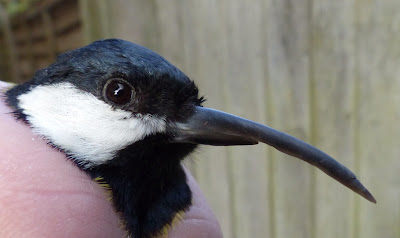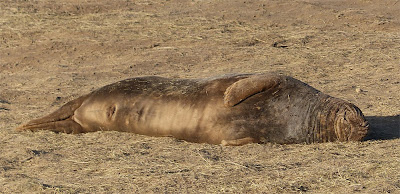January
The start of the year for me was all about trying to see as many bird species as possible on the patch. There were no real highlights to speak of with this, that came in the form of a recovery notification from the BTO of one of the common nightingales that I had ringed at Botley Wood. Unfortunately the bird was found dead in France 488 days since being ringed, which was not good news for the bird, but was my first foreign control of this species since starting the project.
 |
| Adult Common Nightingale - Sadly found dead in France |
February
The long staying and very confiding black-bellied dipper at the BTO HQ Thetford in Norfolk was the first that I had seen in the UK, and got my annual Norfolk pilgrimage off to a good start.
 |
| Black-bellied Dipper - Norfolk |
March
Eurasian siskins came into my garden in good numbers this year and I ended with a record number of 40 new birds ringed, beating the previous best of 12 back in 2003. Individuals were trapped throughout January, February, March, April, May and one bird was re-trapped in August. The peak month though was March when 22 new birds were ringed.
 |
| Male Eurasian Siskin |
April
The return of the common nightingale is always a highlight for me and this year was no exception. At least eight singing males were back on territories, and I managed to catch four of those, one being a bird from May 2009. This month was also memorable for the presence of a singing male common redstart and a lesser spotted woodpecker, both found whilst surveying for nightingales.
 |
| Retrap Adult Nightingale - Botley Wood |
May
Being my 25th wedding anniversary this year my wife and I took short break to the Greek Island of Rhodes. There were no new birds for me but we did have a great trip with a variety of wildlife being seen. The highlight for me had to be snake-eyed lizard which was stunning beast, the resultant blog post has become the most read post on this site.
 |
| Snake-eyed Lizard, Rhodes |
June
The undoubted highlight for me this year was being invited out to ring northern goshawk pulli. I had ringed common buzzards before but the size of these birds, in particular the females and their talons was amazing. The low point was being savaged by a cat and spending four days in hospital with an infected arm.
 |
| Juvenile Goshawk |
Mothing really took off this month and checking the trap before work became near on impossible due to the numbers present. On one date I recorded 250 moths of 90 species in the garden and by the end of the year I had recorded 310 species. The second high point was surviving being knocked off my bike by a car and only needing seven stitches in a gash on my chin and having mild concussion for 48 hours.
 |
| White Satin Moth - a new species for me |
August
Ringing was starting to get into full swing at Titchfield Haven and on 17th we ringing 223 new birds, with 24 of those being garden warblers, the most we have ever caught in one day by a long way.
 |
| Garden Warbler - Titchfield Haven |
This month was memorable for two amazing highs, catching my first, and second, Clifden nonpareil moths whilst staying at Castlehaven on the Isle of Wight; and seeing the first brown shrike to ever be recorded in Hampshire. An excellent find by Bob Marchant.
 |
| Clifden Nonpareil at Castlehaven, Isle of Wight |
October
There were many highlights during October, but these were sadly all overshadowed by the untimely death of Tim Lawman, a popular and active member of the Hampshire birding scene. The highlights were finding a yellow-browed warbler at The Hampshire and Isle of Wight Trusts (HIWWT) Testwood Lakes Nature Reserve, and then another at Anton Lakes whilst waiting for Hampshire's second ever Radde's warbler to show. The semi-palmated plover at Sandy Point on Hayling Island, a truly amazing find by Andy Johnson. And if all that wasn't enough, it ended with us catching our first, and Hampshire's third Radde's warbler at Titchfield Haven. What an autumn this turned out to be!
 |
| Radde's Warbler at Titchfield Haven |
November
Ringing bearded reedlings (or parrotbills) at the HIWWTs Farlington Marshes reserve was a real treat, but the undoubted highlight had to be the phenomenal starling roost of 10,000 to 100,000 birds at their Blashford Lakes nature reserve. As natural history spectacles go this is one of the best I have seen and is still continuing as I write this post. If you get the chance it is definitely worth a visit and if you are lucky you may even get the see one of the two bitterns wintering there.
 |
| A Murmuration of Starlings at Blashford Lakes |
December
There is only one contender this month and that was the Brunnich's guillemot in Portland Harbour. We were heading home after spending Christmas in Cornwall and made the short detour. A cracking bird and a British tick for me to end the year on.



























